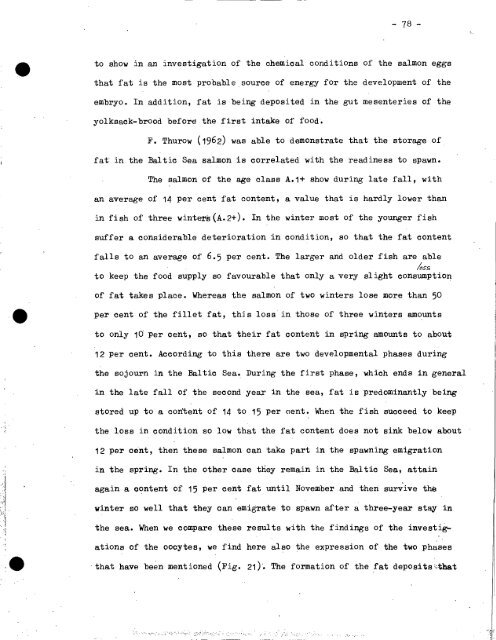Translation Series No.1211
Translation Series No.1211
Translation Series No.1211
You also want an ePaper? Increase the reach of your titles
YUMPU automatically turns print PDFs into web optimized ePapers that Google loves.
- 78 -<br />
to show in an investigation of the chemical conditions of the salmon eggs<br />
that fat is the most probable source of energy for the development of the<br />
embryo. In addition, fat is being deposited in the gut mesenteries of the<br />
yolksack-brood befors the first intake of food - .<br />
F. Thurow (19 62) was able to demonstrate that the storage of<br />
fat in the Baltic Sea salmon is correlated with the readiness to spawn.<br />
The salmon of the age class A.1+ show during late fall, with<br />
an average of 14 Per cent fat content, a value that is hardly lower than<br />
in fish of three winterS(A.2+). In the winter most of the younger fish<br />
suffer a considerable deterioration in condition, so that the fat content<br />
falls to an average of 6.5 per cent. The larger and older fish are able<br />
4.5s<br />
to keep the food supply so favourable that only a very slight consumption<br />
of fat takes place. Whereas the salmon of two winters lose more than 50<br />
per cent of the fillet fat, this loss in those of three winters amounts<br />
to only 10 per cent, so that their fat content in epring amounts to about<br />
12 per cent. According to this there are two developmental phases during<br />
the sojourn in the Baltic Sea. During the first phase, which ends in general<br />
in the late fall of the second yeaT in the sea, fat is predominantly being<br />
stored up to a content of 14 to 15 per cent. When the fish succeed to keep<br />
the loss in condition so low that the fat content does not sink below about<br />
12 per cent, then these salmon can take part in the spawning emigration<br />
in the spring. In the other case they remain in the Baltic Sea, attain<br />
again a content of 15 per cent fat until November and then survive the<br />
winter so well that they can emigrate to spawn after a three-year stay in<br />
the sea. When we compare these results with the findings of the investig<br />
ations of the oocytes, we find here also the expression of the two phases<br />
. that have been mentioned (Fig. 21)". The formation of the fat depositsi;that
















